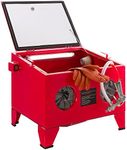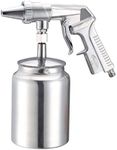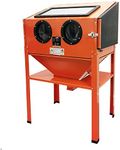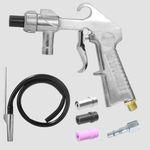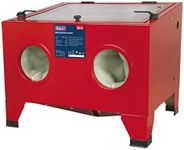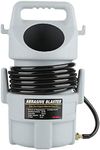Buying Guide for the Best Sand Blasters
Choosing the right sandblaster can make a significant difference in the efficiency and quality of your work. Sandblasters are used for cleaning, smoothing, or etching surfaces by propelling abrasive materials at high speeds. To find the best sandblaster for your needs, you should consider several key specifications. Understanding these specs will help you make an informed decision and ensure that the sandblaster you choose is well-suited to your specific tasks.Type of SandblasterThere are three main types of sandblasters: gravity-fed, siphon, and pressure. Gravity-fed sandblasters use gravity to feed the abrasive material into the gun, making them simple and easy to use for small projects. Siphon sandblasters use a suction system to draw the abrasive material into the gun, suitable for medium-sized tasks. Pressure sandblasters use a pressurized tank to force the abrasive material out at high speeds, ideal for large and heavy-duty projects. Choose the type based on the scale and frequency of your work.
Abrasive Media CompatibilityDifferent sandblasters are compatible with various types of abrasive media, such as glass beads, aluminum oxide, or walnut shells. The type of media you use can affect the finish and efficiency of your work. For example, glass beads are great for a smooth finish, while aluminum oxide is more aggressive for heavy-duty cleaning. Ensure the sandblaster you choose can handle the media type that best suits your project needs.
Air Pressure and Volume RequirementsSandblasters require a certain amount of air pressure (measured in PSI) and air volume (measured in CFM) to operate effectively. Higher PSI and CFM ratings mean the sandblaster can handle more demanding tasks. For light-duty work, a lower PSI and CFM may suffice, but for heavy-duty or continuous use, you'll need a sandblaster with higher ratings. Match the sandblaster's requirements with your air compressor's capabilities to ensure optimal performance.
Nozzle Size and MaterialThe size and material of the nozzle can impact the precision and durability of the sandblaster. Smaller nozzles provide more precision for detailed work, while larger nozzles cover more area for faster completion of large tasks. Nozzles made from materials like ceramic or tungsten carbide are more durable and can withstand the wear and tear of abrasive materials. Choose a nozzle size and material that aligns with the type of work you'll be doing and the longevity you expect from the tool.
Hopper CapacityThe hopper capacity determines how much abrasive material the sandblaster can hold at one time. Larger hoppers allow for longer continuous use without needing to refill, which is beneficial for extensive projects. Smaller hoppers are lighter and easier to handle, making them suitable for smaller, more manageable tasks. Consider the size of your projects and how often you want to stop to refill the hopper when choosing the right capacity.
PortabilityPortability is an important factor if you need to move the sandblaster around frequently. Portable sandblasters are typically lighter and may come with wheels or handles for easy transport. Stationary sandblasters are heavier and more robust, suitable for a dedicated workspace. Think about where and how you'll be using the sandblaster to determine the level of portability you need.
Dust Collection SystemA dust collection system helps to manage the debris and dust generated during sandblasting, keeping your workspace cleaner and safer. Some sandblasters come with built-in dust collection systems, while others may require an external vacuum. If maintaining a clean work environment is important to you, look for a sandblaster with an efficient dust collection system.



